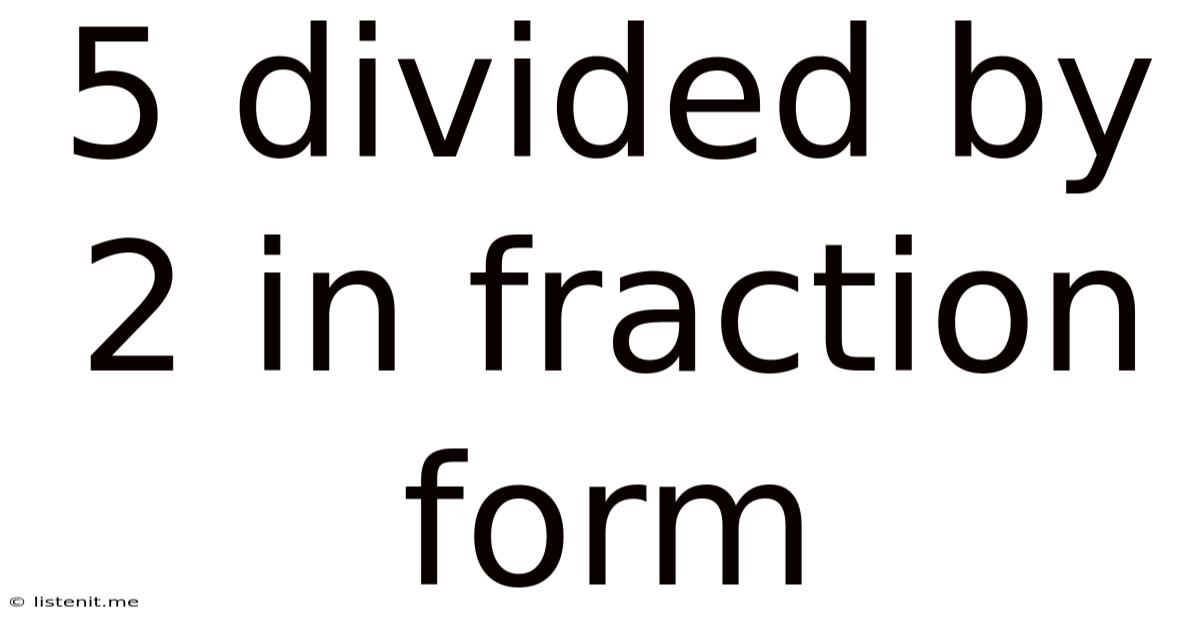5 Divided By 2 In Fraction Form
listenit
May 25, 2025 · 4 min read

Table of Contents
5 Divided by 2 in Fraction Form: A Comprehensive Guide
Dividing numbers is a fundamental concept in mathematics, and understanding how to represent division in fraction form is crucial for various mathematical operations. This comprehensive guide delves into the process of expressing 5 divided by 2 as a fraction, exploring different interpretations and related concepts. We'll cover the basics, delve into more complex scenarios, and even explore real-world applications to solidify your understanding.
Understanding Fractions and Division
Before we tackle 5 divided by 2, let's solidify our understanding of the relationship between fractions and division. A fraction represents a part of a whole. It's structured as a numerator (the top number) over a denominator (the bottom number). The fraction line itself signifies division. Therefore, the fraction a/b is equivalent to a ÷ b.
Key Terminology:
- Numerator: The top number in a fraction, representing the number of parts you have.
- Denominator: The bottom number in a fraction, representing the total number of equal parts the whole is divided into.
- Proper Fraction: A fraction where the numerator is smaller than the denominator (e.g., 1/2, 3/4).
- Improper Fraction: A fraction where the numerator is greater than or equal to the denominator (e.g., 5/2, 7/3).
- Mixed Number: A number consisting of a whole number and a proper fraction (e.g., 2 1/2).
Expressing 5 Divided by 2 as a Fraction
The problem "5 divided by 2" can be directly translated into fraction form:
5 ÷ 2 = 5/2
This is an improper fraction because the numerator (5) is larger than the denominator (2). This simply means we have more than one whole.
Converting Improper Fractions to Mixed Numbers
Improper fractions are often converted to mixed numbers for easier interpretation. To convert 5/2 to a mixed number, we perform the division:
5 ÷ 2 = 2 with a remainder of 1.
This means that 5/2 contains two whole units and one remaining part out of two. Therefore:
5/2 = 2 1/2
This is read as "two and one-half." Both 5/2 and 2 1/2 represent the same value; they're just expressed differently.
Visualizing 5/2
Imagine you have five pizzas, and you want to divide them equally among two people. Each person would receive two whole pizzas (2 x 2 = 4 pizzas), leaving one pizza remaining. You would then divide that remaining pizza in half, giving each person an additional 1/2 pizza. Thus, each person receives 2 1/2 pizzas. This visual representation helps to solidify the concept of the improper fraction and its mixed number equivalent.
Real-World Applications of 5/2 and its Conversions
The concept of dividing 5 by 2 appears in numerous real-world scenarios:
- Sharing Resources: Dividing five cookies equally among two friends.
- Measurement: Cutting a 5-meter length of rope into two equal parts.
- Recipe Scaling: If a recipe calls for 2.5 cups of flour and you want to double it, you'll need 5 cups, which is 5/2 doubled, resulting in 5 cups.
- Average Calculation: Finding the average score of two tests, where one score is 3 and the other is 7 (3+7 = 10, and 10/2 = 5). Then, if you need to divide that average by 2, it's 5/2.
In each of these cases, understanding how to represent and interpret 5/2, whether as an improper fraction or a mixed number, is essential for accurate calculations and problem-solving.
Extending the Concept: Working with Other Fractions
The principles discussed for 5/2 can be extended to other division problems that result in fractions. For example:
- 7 ÷ 3 = 7/3 = 2 1/3
- 11 ÷ 4 = 11/4 = 2 3/4
- 15 ÷ 7 = 15/7 = 2 1/7
These examples demonstrate the consistent relationship between division and fractions. The process of converting improper fractions to mixed numbers remains the same: divide the numerator by the denominator; the quotient becomes the whole number part, and the remainder becomes the numerator of the fraction, with the original denominator remaining unchanged.
Decimal Equivalents and Further Exploration
While fractions effectively represent 5 divided by 2, it's also helpful to understand its decimal equivalent. Performing the division 5 ÷ 2 yields 2.5. This illustrates the interchangeable nature of fractions and decimals.
Beyond the Basics: Operations with Fractions
Once you understand how to represent division as a fraction, you can apply this knowledge to more complex mathematical operations involving fractions, such as:
- Addition and Subtraction of Fractions: Requires finding a common denominator.
- Multiplication and Division of Fractions: Involves multiplying or dividing numerators and denominators.
Conclusion: Mastering Fractions and Division
Understanding how to express 5 divided by 2 as a fraction (5/2) and its equivalent mixed number (2 1/2) is a fundamental building block in mathematics. This knowledge isn't confined to abstract mathematical exercises; it has practical applications in various real-world scenarios. By mastering the principles discussed in this comprehensive guide, you can confidently tackle more complex fraction problems and improve your overall mathematical proficiency. Remember the visual aids and practical examples; they significantly improve the understanding and retention of this critical mathematical concept. From sharing resources fairly to scaling recipes accurately, the ability to work with fractions is an invaluable life skill.
Latest Posts
Latest Posts
-
10 Gallons Of Gas How Many Miles
May 25, 2025
-
What Is 8 12 4 8 Reduced To The Lowest Terms
May 25, 2025
-
Factors Of That Add Up To 1
May 25, 2025
-
Gcf Of 18 36 And 45
May 25, 2025
-
How Long Is 8am To 12pm
May 25, 2025
Related Post
Thank you for visiting our website which covers about 5 Divided By 2 In Fraction Form . We hope the information provided has been useful to you. Feel free to contact us if you have any questions or need further assistance. See you next time and don't miss to bookmark.